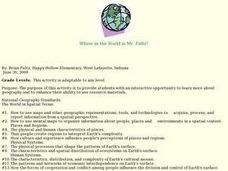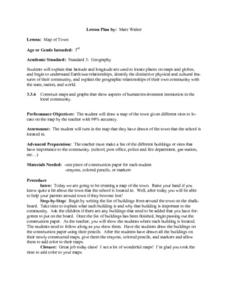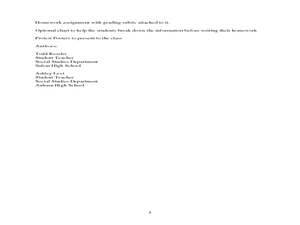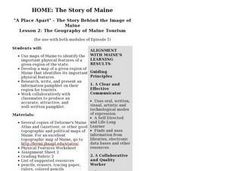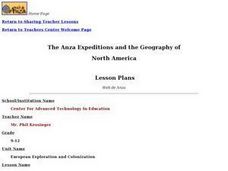Curated OER
The Mayan Empire
Students study vocabulary associated with the Mayan Empire; its art, daily life, inventions, and religious beliefs. They examine why the Mayan culture is considered to be one of the most advanced of the ancient civilizations by...
Curated OER
Using Venn Diagrams to Compare Two Ecosystems
Students explore the distribution of two ecosystems on a global scale; and map the distribution of tropical and temperate rain forests throughout the world. They use a Venn Diagram to describe these ecosystems and the differences between...
Curated OER
Keith Haring & Social Awareness
Students view four sections of one of Haring's paintings. They describe the people and characters they see. Students participate in a variety of classroom art activities such as: Making a treasure box modeled after Keith Haring's work,...
Curated OER
Where in the World is Mr. Fultz?
Students use maps and other geographic resources to learn about their world while problem solving. They read clues each day and use classroom resources to narrow down where the prize is located.
Curated OER
Map of Town
Third graders draw a map of the town given different sites to locate on the map by the teacher. They explain that latitude and longitude are used to locate places on maps and globes, identify the distinctive physical and cultural...
Curated OER
Who Eats Whom in the Salt Marsh?
Seventh graders complete a virtual online salt marsh tour. In groups, they observe and identify the various types of animals found in the marsh. After categorizing the animals, they create a food web based on the animals role in the...
Curated OER
Healthy Water!?
Students test water for its quality and record their information.In this water quality lesson, students investigate water for pH, macro invertebrates and identify its characteristics. Students complete worksheets on their data for their...
Curated OER
Identifying Watersheds with Topographic Maps
Students model a watershed and delineate one using topographic maps. For this hydrology lesson, students use aluminum foil to model a landscape and observe how water moves on it. They also observe the features of a topographic map and...
Curated OER
Sounds Good to Me
Students determine density and hardness of wood samples based on several investigations. In this physical science and music lesson, students visit four centers and perform tests on wood samples to determine densities and hardnesses. They...
Curated OER
1968 – A Generation in Revolt
Tenth graders compare and contrast the revolts that took place around the world in 1968. In this global studies lesson, 10th graders research the youth revolts that took place in Paris, Prague, and Chicago in 1968 and create posters and...
Curated OER
Sahara Special
Third graders read the book Sahara Special and participate in comprehension activities. In this realistic fiction lesson, 3rd graders create a brochure for where they live. Students have personal bags, a brown paper bag, that they fill...
Curated OER
Hershey and the World: The 5 Themes of Geography and Google Earth
Learners invsestigate cocoa producing regions in the world. In this geography skills lesson, students examine how the 5 themes of geography affect the Hershey Chocolate Company as they compare and contrast cocoa production in America,...
Curated OER
"Trails, Rails, and Roads" Lesson 2: Road Tripping
Young scholars practice map skills and take a virtual road trip through Maine examining the history of transportation. They create questions from the information they learned and play a game against other groups.
Curated OER
Lesson 4: A Field Trip to the Maine State Museum
Students analyze the Maine State Museum's exhibit 12,000 Years in Maine. They create an artifact and write a description of that artifact that demonstrates their understanding of the way technology shapes culture.
Curated OER
Geography: World Dynamics
Students discuss and examine how the world is changing. After reading an article, they discover the immediate changes that have taken place and how they have effected living things. They complete a worksheet identifying the changes as...
Curated OER
The Geography of Maine Tourism
Learners study topographical maps of Maine to identify the important physical features. They work in groups to create tourism pamphlet highlighting a region of the state.
Curated OER
Planning a Healthy City
Ninth graders create a scaled model city. They create a blueprint that provides for the economic and cultural needs of a community. They identify where essential elements of the city should be located and explain the rationale for the...
Curated OER
Conditions in And Connections To Indonesia
Eleventh graders research an animal and its habitat, the conditions of that habitat and how its connections to the rest of the world are affecting that habitat.
Curated OER
Home: the Story of Maine "A Love for the Land": Where Are You? Who Are You?
Students investigate their neighborhood both as it is now and as it was 100 years ago. They take a walk around their neighborhood and fill out a worksheet before completing a worksheet.
Curated OER
Lesson 3: Making a Living
Students, in groups, create hypothetical financial plans for a colonial Maine family living on the frontier.
Curated OER
Where's King Solomon when we need him?: Good decisions on resources
Students use geographic information to suggest how to manage natural resources through a simulation. They engage in a simulation, and decide how to protect, allocate, and exploit the resources of a hypothetical location.
Curated OER
Spanish Colonization: The Anza Expedition
Learners research the Spanish explorations and North American geography. They create web pages based on their study.
Curated OER
The Importance and Future Of Canadian Resources
Ninth graders examine Canadian natural resources. In this geography skills lesson plan, 9th graders research answers to questions regarding Canada's water, energy, forests, and wildlife. Students use their findings to create posters that...
Curated OER
Weather in the USA
Students identify the different types of weather conditions that occur in the United States. They discover how to adapt to weather and explain forecast and warning signals.





